Discover 35 hidden attractions, cool sights, and unusual things to do in Charlottesville (United States). Don't miss out on these must-see attractions: Monticello, Statue of Thomas Jefferson, and Michie Tavern. Also, be sure to include The Corner in your itinerary.
Below, you can find the list of the most amazing places you should visit in Charlottesville (Virginia).
Table of Contents
Monticello

Thomas Jefferson's famed plantation home. Monticello was the primary plantation of Thomas Jefferson, the third president of the United States, who began designing Monticello after inheriting land from his father at age 26. Located just outside Charlottesville, Virginia, in the Piedmont region, the plantation was originally 5,000 acres, with Jefferson using the labor of enslaved African people for extensive cultivation of tobacco and mixed crops, later shifting from tobacco cultivation to wheat in response to changing markets. Due to its architectural and historic significance, the property has been designated a National Historic Landmark. In 1987, Monticello and the nearby University of Virginia, also designed by Jefferson, were together designated a UNESCO World Heritage Site. The current nickel, a United States coin, features a depiction of Monticello on its reverse side.
Jefferson designed the main house using neoclassical design principles described by Italian Renaissance architect Andrea Palladio and reworking the design through much of his presidency to include design elements popular in late 18th-century Europe and integrating numerous ideas of his own. Situated on the summit of an 850-foot (260 m)-high peak in the Southwest Mountains south of the Rivanna Gap, the name Monticello derives from Italian meaning "little mountain". Along a prominent lane adjacent to the house, Mulberry Row, the plantation came to include numerous outbuildings for specialized functions, e.g. a nailery; quarters for enslaved Africans who worked in the home; gardens for flowers, produce, and Jefferson's experiments in plant breeding—along with tobacco fields and mixed crops. Cabins for enslaved Africans who worked in the fields were farther from the mansion, out of Jefferson's sight both literally and figuratively.
At Jefferson's direction, he was buried on the grounds, in an area now designated as the Monticello Cemetery. The cemetery is owned by the Monticello Association, a society of his descendants through Martha Wayles Skelton Jefferson. After Jefferson's death, his daughter Martha Jefferson Randolph sold the property. In 1834, it was bought by Uriah P. Levy, a commodore in the U.S. Navy, who admired Jefferson and spent his own money to preserve the property. His nephew Jefferson Monroe Levy took over the property in 1879; he also invested considerable money to restore and preserve it. In 1923, Monroe Levy sold it to the Thomas Jefferson Foundation (TJF), which operates it as a house museum and educational institution.[1]
Address: 931 Thomas Jefferson Pkwy, 22902 Charlottesville
Statue of Thomas Jefferson

Thomas Jefferson is a statue of U.S. Founding Father and president Thomas Jefferson in front of the Rotunda at the University of Virginia, the university he founded and designed. The statue was crafted by Moses Ezekiel in 1910 and was a copy of the Jefferson statue in Louisville, Kentucky.[2]
Michie Tavern
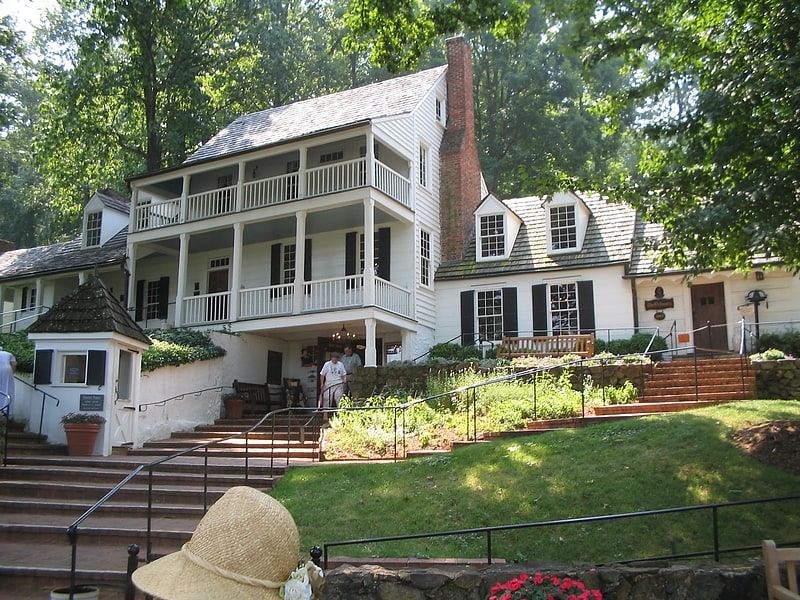
Historical landmark in Albemarle County, Virginia. Michie Tavern, located in Albemarle County, Virginia, is a Virginia Historic Landmark that was established in 1784 by Scotsman William Michie, though in Earlysville. The Tavern served as the social center of its community and provided travelers with food, drink and lodging. It remained in operation, in the Michie family, until 1910, when it came to be owned by the Commonwealth of Virginia. In 1927, the Tavern was purchased by the Josephine Henderson, who had it moved seventeen miles from Earlysville to its present location, close to Monticello.[3]
Address: 683 Thomas Jefferson Pkwy, 22902-7145 Charlottesville
The Corner
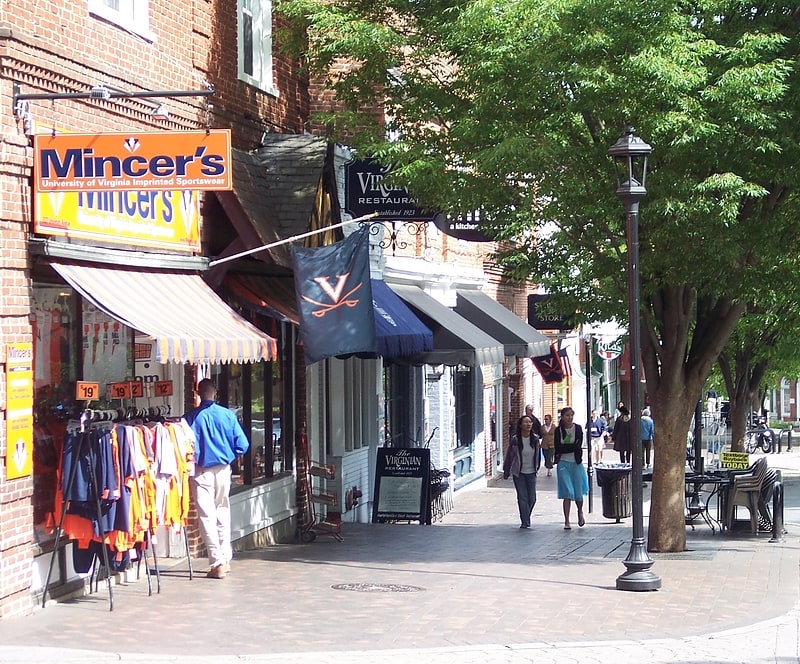
The Corner is a seven-block collection of bars, restaurants, bookstores, and night spots on University Avenue in Charlottesville, Virginia, extending from 121⁄2 Street Southwest to Chancellor Street. located across the street from the University of Virginia. It is bounded by Graduate Charlottesville on the east and Bank of America on the west.
While the university is in session, The Corner is especially active at lunchtime, when faculty, staff, and students adjourn there for the midday meal. Patrons of the Corner's sidewalk cafés can be found spending time over a good book or simply sipping coffee and people watching. Of the 67 businesses in the district, all but sixteen are locally owned, though there has been an increase in chain stores recently. The Corner is encompassed by a Charlottesville historic district, limiting redevelopment and demolition.
As of 2000, The Corner had 26 restaurants, eleven bars, three coffee shops, one hotel, and one apartment building.[4]
John Paul Jones Arena
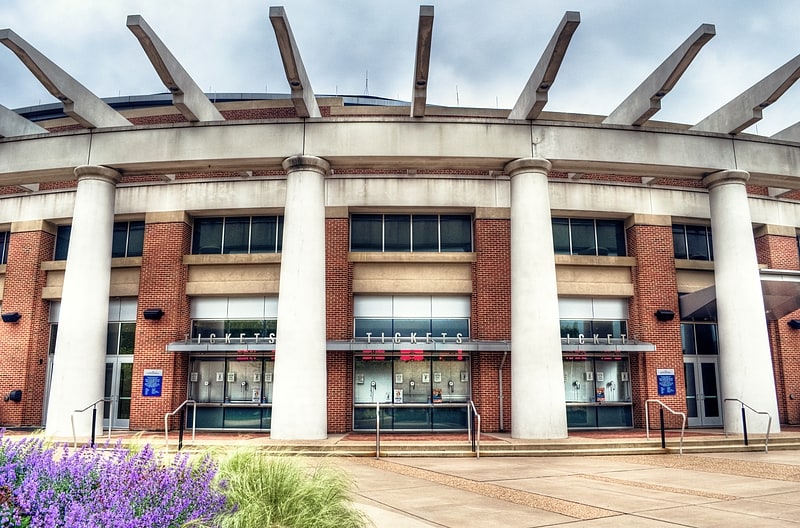
Arena in Albemarle County, Virginia. John Paul Jones Arena, or JPJ, is a multi-purpose arena owned by the University of Virginia in Charlottesville, Virginia. Since November 2006, it serves as the home to the Virginia Cavaliers men's and women's basketball teams, as well as for concerts and other events. With seating for 14,593 fans John Paul Jones Arena is the largest indoor arena in Virginia and the biggest Atlantic Coast Conference basketball arena located outside of large metropolitan areas. Sports Illustrated named John Paul Jones Arena the best new college basketball arena of the 2000s.
Virginia men's basketball is 206–46 (.817) at John Paul Jones Arena as of March 2021. The Cavaliers have fared even better, 167–30 (.848), at JPJ during the Tony Bennett era. Virginia fans in the arena are known for cheering loudly for defensive stands and for providing what Rick Pitino, who went winless in three attempts at JPJ, called "one of the best home court advantages ever seen" where Wahoo fans seem like they are "on top of you." JPJ opened for basketball on November 12, 2006, as Virginia defeated No. 10 ranked Arizona, 93–90, and handed Lute Olson a season-opening loss in his final season.[5]
Address: 295 Massie Rd, 22903-1767 Charlottesville
Scott Stadium
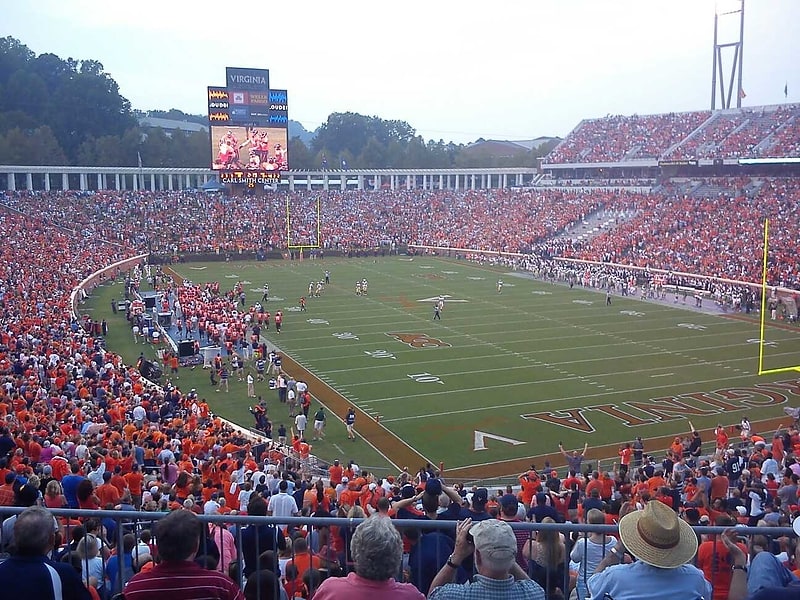
Stadium in Albemarle County, Virginia. Scott Stadium is a stadium located in Charlottesville, Virginia. It is the home of the Virginia Cavaliers football team. It sits on the University of Virginia's Grounds, east of Hereford College and first-year dorms on Alderman Road but west of Brown College and the Lawn. Constructed in 1931, it is the oldest active FBS football stadium in Virginia.
It also hosts other events, such as concerts for bands that can fill an entire stadium, such as the Dave Matthews Band in 2001, the Rolling Stones in 2005, and U2 in 2009. The Virginia High School League held its Group AAA Division 5 and 6 football state championship games at the stadium until 2015. The facility has also hosted the Division I NCAA Men's Lacrosse Championship in 1977 and 1982 and the ACC Women's Lacrosse Tournament in 2008.[6]
Address: 1815 Stadium Rd, 22903-3120 Charlottesville
McIntire Amphitheatre

Theater in Albemarle County, Virginia. The McIntire Amphitheatre is a Greek-style outdoor theater at the University of Virginia. Established in 1921 with a $120,000 gift from benefactor and University alum Paul Goodloe McIntire, it is now used for a variety of outdoor gatherings including concerts, speakers, and other events.[7]
Fralin Museum of Art
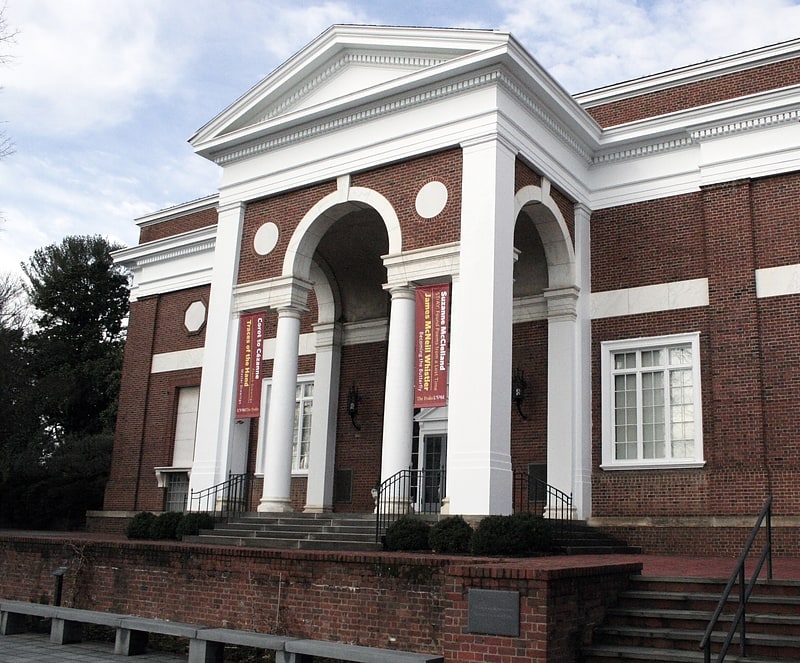
Museum in Albemarle County, Virginia. The Fralin Museum of Art is an art museum at the University of Virginia. Before 2012, it was known as the University of Virginia Art Museum. It occupies the historic Thomas H. Bayly Building on Rugby Road in Charlottesville, Virginia, a short distance from the Rotunda. The museum's permanent collection consists of nearly 14,000 works; African art, American Indian art, and European and American painting, photography, and works on paper are particularly well represented. The Fralin serves as a teaching museum for academic departments in the university, and serves the community at large with several outreach programs. Admission is free of charge and open to the public.
In the spring of 2012, Cynthia and W. Heywood Fralin announced a bequest of their collection of American art to the museum. In honor of their gift and Heywood Fralin's service to the university and to the arts in Virginia, the Board of Visitors voted to name the museum The Fralin Museum of Art.[8]
Address: 155 Rugby Rd, 22903-2427 Charlottesville
Rugby Road
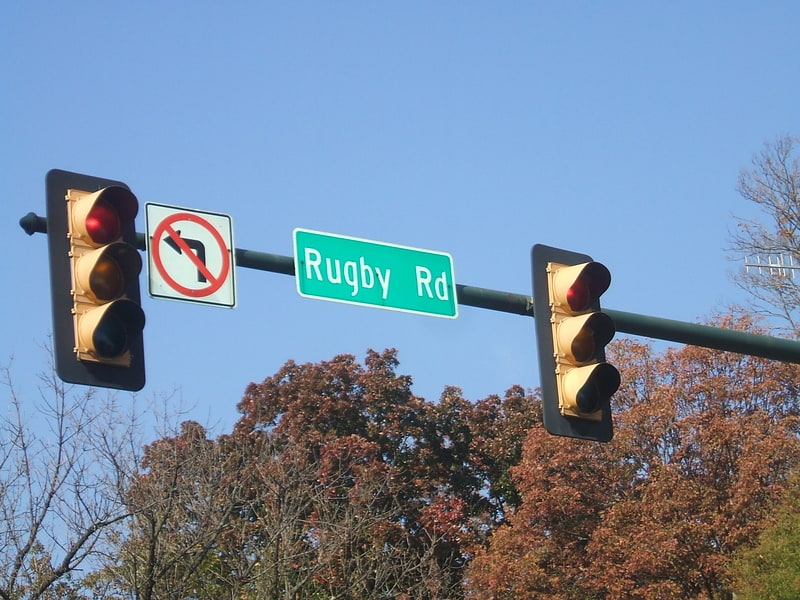
Rugby Road is a street in Charlottesville, Virginia that serves as the center of the University of Virginia's fraternity and sorority system and its attendant social activity. It is located across the street from central Grounds, beginning at University Avenue across the street from the Rotunda branching off at Preston Avenue and finally curving down to the 250 Bypass, and marks one end of The Corner, a strip of restaurants and stores that cater mainly to students. Rugby Road is lined with a variety of architecturally significant houses from several different decades. Many of these are currently used by fraternities and sororities, although the majority of them were originally intended for single-family use; William Faulkner was one famous resident while he was a writer in residence at the University.
In addition to its social role, Rugby Road is also home to a variety of institutions and well known structures with a wide range of uses and purposes. These include Madison House, the University of Virginia School of Architecture, Mad Bowl, Beta Bridge, the Bayly Art Museum, and the official university structures on Carr's Hill, Fayerweather Hall and the President's House.[9]
Ash Lawn–Highland
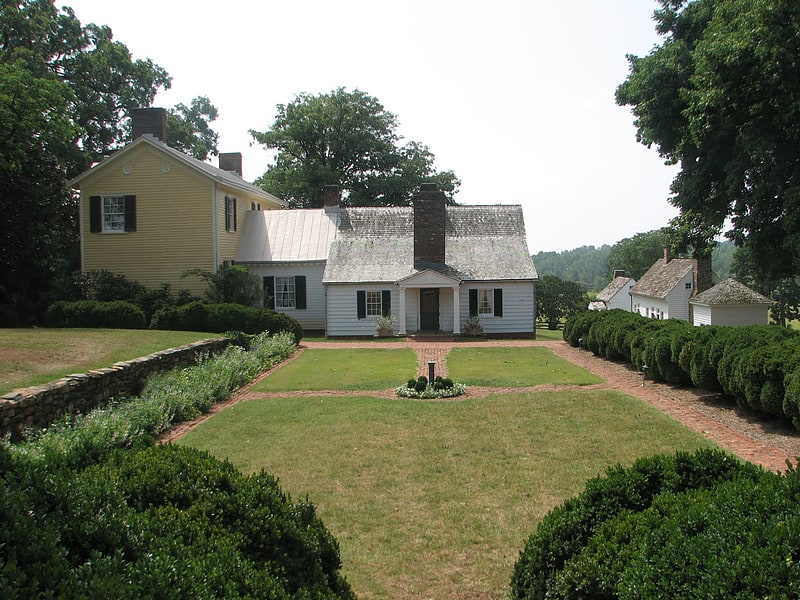
Historical landmark in Albemarle County, Virginia. Highland, formerly Ash Lawn–Highland, located near Charlottesville, Virginia, United States, and adjacent to Thomas Jefferson's Monticello, was the estate of James Monroe, fifth president of the United States. Purchased in 1793, Monroe and his family permanently settled on the property in 1799 and lived at Highland for twenty-five years. Personal debt forced Monroe to sell the plantation in 1825. Before and after selling Highland, Monroe spent much of his time living at the plantation house at his large Oak Hill estate near Leesburg, Virginia.
Monroe named his Charlottesville home "Highland". For many years after Monroe's death until 2016, the house was known as Ash Lawn-Highland or merely Ash Lawn.
The estate is now owned, operated and maintained by Monroe's alma mater, the College of William & Mary.[10]
Jefferson Theater
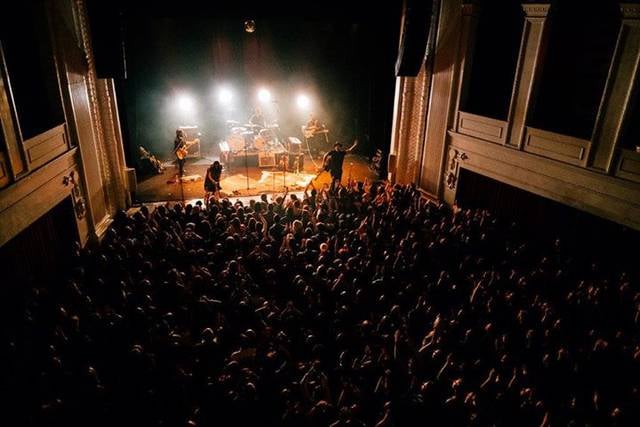
Theater in Charlottesville, Virginia. The Jefferson Theater, a former movie palace, is a performing arts venue located at 110 East Main Street in Charlottesville, Virginia, and is the centerpiece of the Historic Downtown Mall.
Built in 1912, this combination vaudeville house/cinema is one of the major performing venues in Charlottesville, Virginia. Operated most recently as one of the dollar theaters, it is currently owned by Coran Capshaw, who oversaw restoration which has now been completed.
It was designed by architect C.K. Howell, who also designed the November Theatre in nearby Richmond, Virginia.
Before closing for renovations in the spring of 2006, one of the final performances was a concert by the Charlottesville-based bluegrass band, King Wilkie.[11]
Address: Charlottesville, 110 East Main St.
University of Virginia Darden School of Business

Business school in Charlottesville, Virginia. The Darden School of Business is the graduate business school associated with the University of Virginia in Charlottesville, Virginia. The Darden School offers MBA, Ph.D. and Executive Education programs. The School was founded in 1955 and is named after Colgate Whitehead Darden Jr. a former Democratic congressman, governor of Virginia, and former president of the University of Virginia. Darden is on the grounds of the University of Virginia in Charlottesville. The School is famous for being one of the most prominent business schools to use the case method as its sole method of teaching. The Dean of the school is former McKinsey & Company executive, Scott C. Beardsley.[12]
Address: 100 Darden Blvd, Charlottesville
Paramount Theater
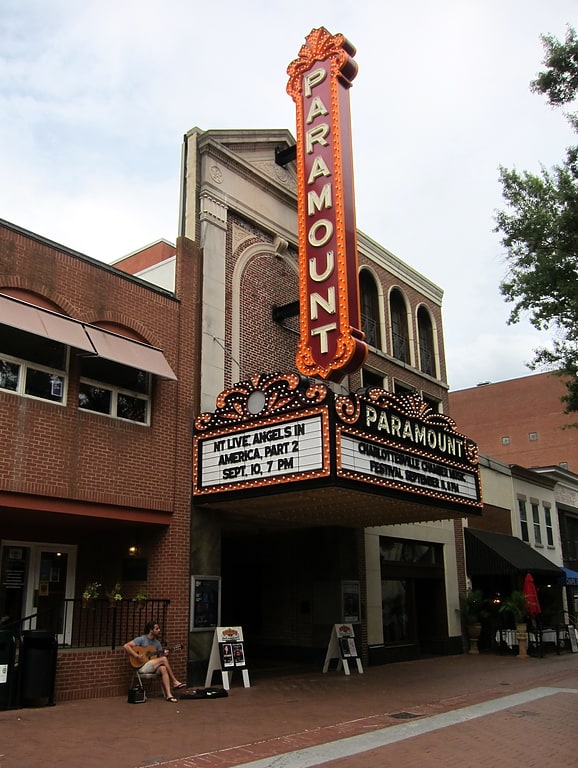
Theater in Charlottesville, Virginia. The Paramount Theater in Charlottesville, Virginia, United States was designed by Rapp and Rapp and opened in 1931 as a movie theater. The Paramount continued showing movies until it closed in 1974. In 1990 a group of community members purchased the theater, formed a nonprofit corporation and began raising funds for its restoration and expansion. In late 2004 the Paramount re-opened after an $18 million renovation. It is operated by a non-profit organization and is a performing arts venue for the community.
Beginning in 2009 the theater has played host to performances by Charlottesville Opera.[13]
Address: Charlottesville, 215 East Main Street
Jefferson School City Center

School in Charlottesville, Virginia. The Jefferson School is a historic building in Charlottesville, Virginia. It was built to serve as a segregated high school for African-American students. The school, located on Commerce Street in the downtown Starr Hill neighborhood, was built in four sections starting in 1926, with additions made in 1938–39, 1958, and 1959. It is a large two-story brick building, and the 1938–1939, two-story, rear addition, was partially funded by the Public Works Administration.
This building operated from 1926 to 1951 as Charlottesville's first high school for Black students. In 1951, it became an elementary school for Black students. In 1958, Jefferson School students sought application to local white-only schools, sparking the city government to join the statewide massive resistance movement against school integration. After serving many uses over the following decades, it reopened in 2013 as the Jefferson School City Center, a multi-use facility that houses the Jefferson School African American Heritage Center, the Carver Recreation Center, and local community organizations.[14]
Address: 233 4th St NW, 22903-4593 Charlottesville
Emancipation Park
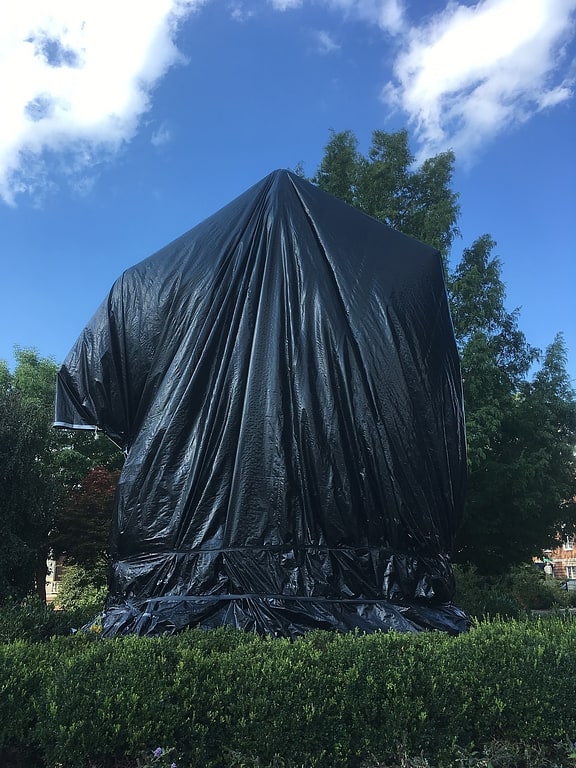
Park in Charlottesville, Virginia. Market Street Park, known as Lee Park until 2017, and as Emancipation Park from June 2017 to July 2018, is a public park in Charlottesville, Virginia.[15]
Address: 101 East Market Street, Charlottesville
Meriwether Lewis and William Clark Sculpture

Sculpture by Charles Keck. Meriwether Lewis and William Clark was a historic bronze sculpture of Meriwether Lewis, William Clark, and Sacagawea located at Charlottesville, Virginia. Known as Their First View of the Pacific, it was sculpted by noted artist Charles Keck, and was the first of four commemorative sculptures commissioned from members of the National Sculpture Society by philanthropist Paul Goodloe McIntire. The sculpture was erected in 1919.
It was listed on the National Register of Historic Places in 1997.
On July 10, 2021, following the removal of the Thomas Jonathan Jackson and Robert E. Lee statues, the city called for an emergency council meeting where it was decided that the statue, along with the George Rogers Clark sculpture, would also be removed that same day. It was removed at the request of descendants of Sacajawea.[16]
University of Virginia Cemetery
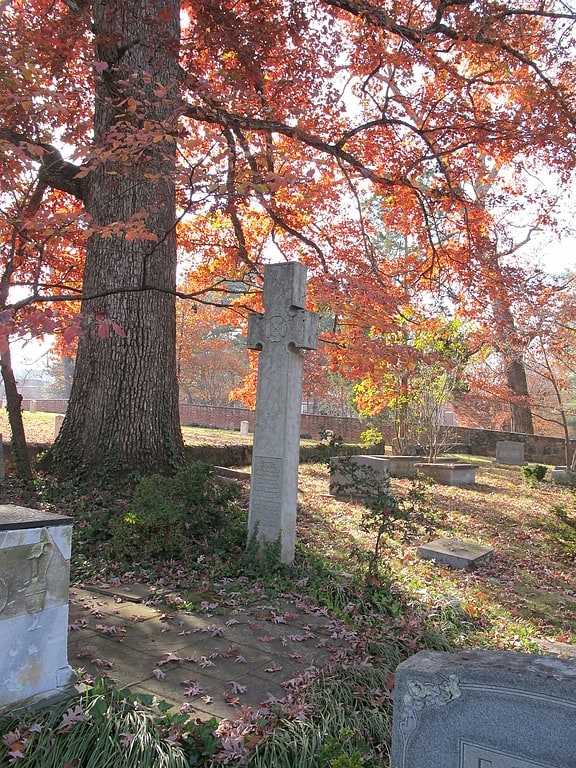
Cemetery in Albemarle County, Virginia. The University of Virginia Cemetery and Columbarium is a cemetery on the Grounds of the University of Virginia, located at the intersection of McCormick Road and Alderman Road. In operation since 1828, during the earliest days of the University, the cemetery is the final resting place for many University of Virginia professors, administrators, and alumni. It includes a large burial area that holds the remains of 1,097 Confederate States Army soldiers. The cemetery is in two sections; the newer section includes a columbarium to provide more space for burials.[17]
Equestrian statue of Stonewall Jackson
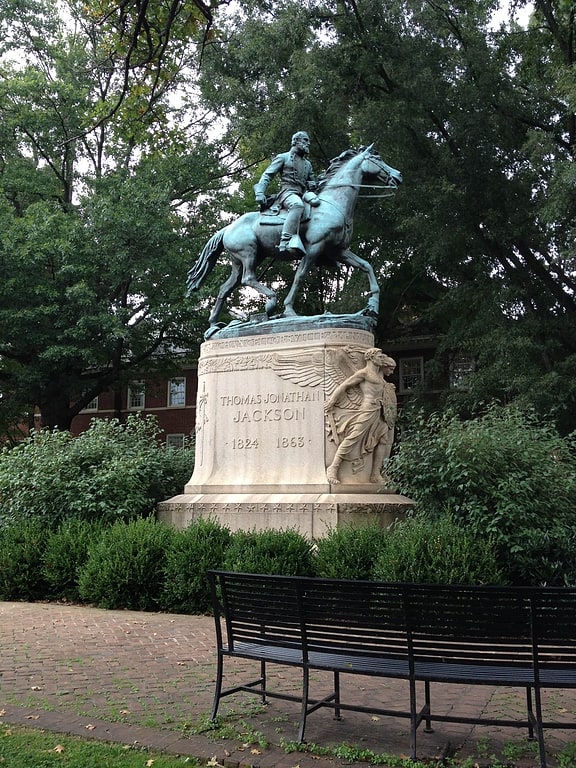
Sculpture by Charles Keck. Thomas Jonathan Jackson is a historic bronze equestrian statue of Confederate general Stonewall Jackson which was formerly located at Courthouse Historic District of Charlottesville, Virginia and installed in 1921. The statue was sculpted by Charles Keck and was the third of four works commissioned from members of the National Sculpture Society by philanthropist Paul Goodloe McIntire. It was the second of three statues McIntire donated to the city of Charlottesville, which he did over a period of five years from 1919 to 1924. The statue was listed on the National Register of Historic Places in 1997.[18]
Riverview Cemetery
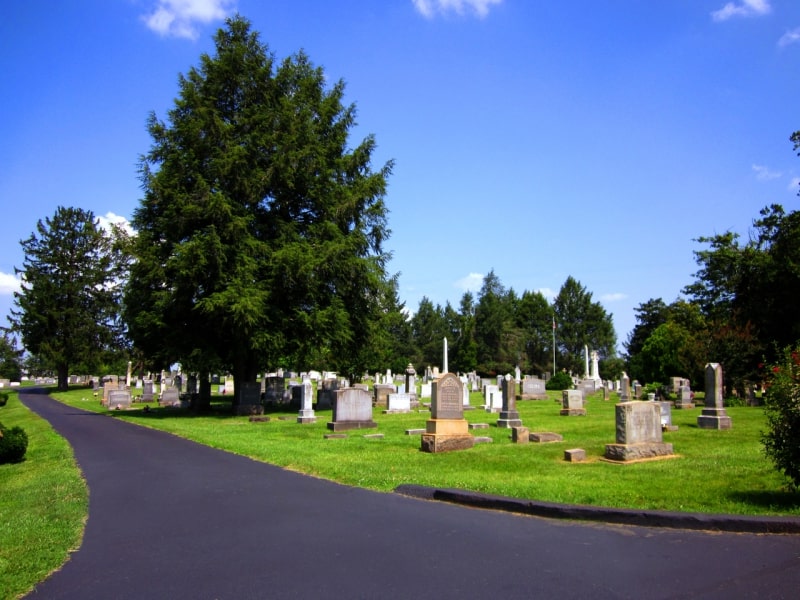
Cemetery in Charlottesville, Virginia. Riverview Cemetery is a private cemetery located in the Woolen Mills section of Charlottesville, Virginia, at 1701 Chesapeake Street. Founded in 1892 as Charlottesville's two public cemeteries—Maplewood and Oakwood—were filling up, Riverview consists of about 50 acres overlooking a bend in the Rivanna River and has approximately 12,000 graves with room for about 7,000 more.[19]
The Rotunda
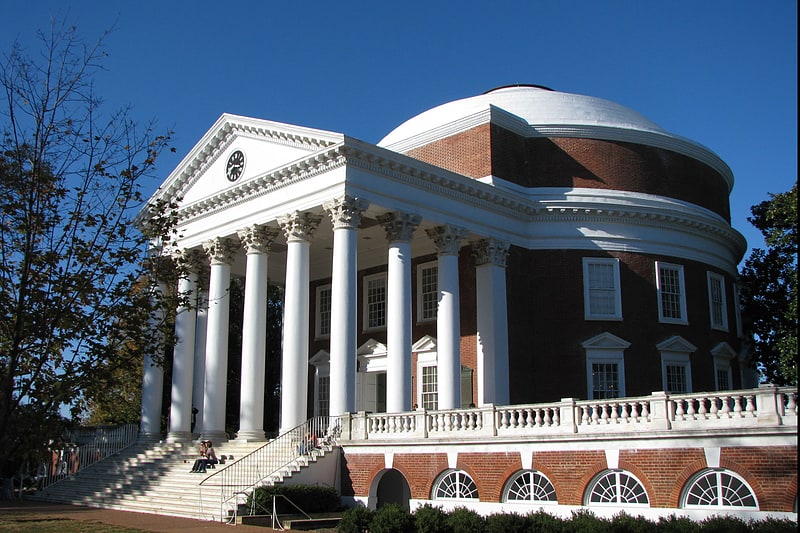
Building in Albemarle County, Virginia. The Rotunda is a building located on The Lawn on the original grounds of the University of Virginia. Thomas Jefferson designed it to represent the "authority of nature and power of reason" and modeled it after the Pantheon in Rome. Construction began in 1822 and was completed shortly after Jefferson's death in 1826. The campus of the new university was unique in that its buildings surrounded a library rather than a church, as was common at other universities in the English-speaking world. To many, the Rotunda symbolizes Jefferson's belief in the separation of church and education, and represents his lifelong dedication to education and architecture. The Rotunda was designated a National Historic Landmark in 1966, and is part of the University of Virginia Historic District, designated in 1971.
The collegiate structure, the immediate area around it, and Jefferson's nearby home at Monticello combine to form one of only six modern man-made sites in the United States to be internationally protected and preserved as a World Heritage Site by UNESCO (the other five are the Old City of San Juan, the San Antonio Missions, Independence Hall, the Statue of Liberty and the architectural works of Frank Lloyd Wright).
The original construction cost of the Rotunda was $57,773 ($992,792 in 2006 dollars). The building stands 77 feet (23.5 m) in both height and diameter.[20]
Address: 211 Emmet St S, Charlottesville
Robert E. Lee Monument
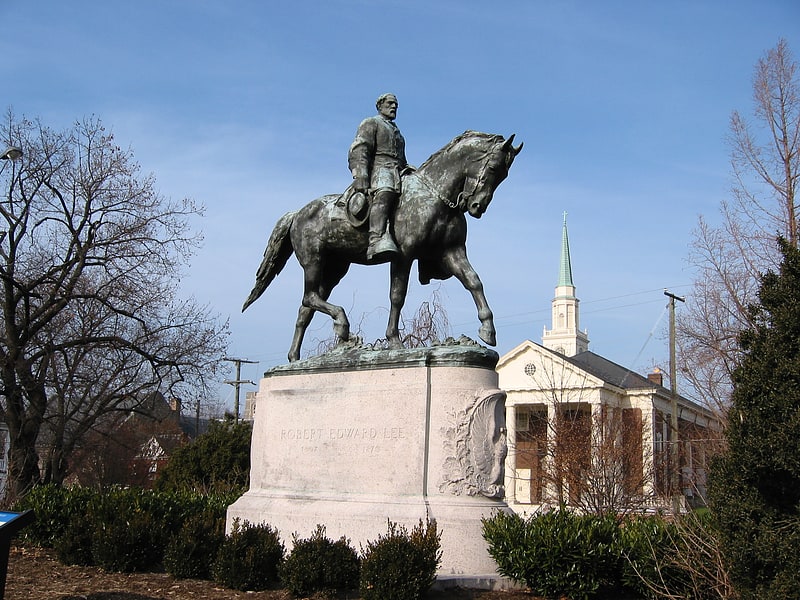
Statue by Henry Shrady and Leo Lentelli. The Robert E. Lee Monument was an outdoor bronze equestrian statue of Confederate general Robert E. Lee and his horse Traveller located in Charlottesville, Virginia's Market Street Park in the Charlottesville and Albemarle County Courthouse Historic District. The statue was commissioned in 1917 and dedicated in 1924, and in 1997 was listed on the National Register of Historic Places. It was removed on July 10, 2021.
In February 2017, as part of the movement for the removal of Confederate monuments and memorials, the Charlottesville City Council voted 3–2 for the statue's removal, along with the Stonewall Jackson statue, and for the Lee Park to be renamed. The removal proposal generated controversy. A lawsuit was filed on March 20, 2017, and in May 2017 a temporary injunction against its removal was granted by a judge, citing a Virginia state law that blocked the removal. White supremacists organized the Unite the Right rally for August 2017 to protest the proposed removal that drew numerous far-right groups from across the United States; this rally in turn caused counterdemonstrations, which in turn caused serious clashes; the event took a deadly turn when a white supremacist rammed a car into a crowd of counterdemonstrators, killing one and wounding 35. On August 23, 2017, the council had the statue shrouded in black, which in February 2018 a judge ordered removed. In July 2019 a permanent injunction was granted and in July 2020 the state law was amended to remove the grounds for objection raised by the judge. The Virginia Supreme Court lifted the injunction in April 2021, holding that the state law thought to restrict the removal did not apply retroactively to statutes passed before its effect (the law was applied to Virginia cities in 1997, but the statue had been erected in 1924). However, rather than immediately remove the statute, the city opted to employ the new removal process authorized under the law's 2020 amendments, which entails public notice, a public hearing after thirty days, and thirty days to field offers for relocation of the statue. On July 9, 2021, the City Council announced that the Lee Monument would be removed the following day, and, on July 10, 2021, both the Lee and Stonewall Jackson statues were removed by the city.[21]
The Aviator

Sculpture by Gutzon Borglum. The Aviator is a historical sculpture located on the University of Virginia campus near Charlottesville, Albemarle County, Virginia.[22]
Cville Escape Room
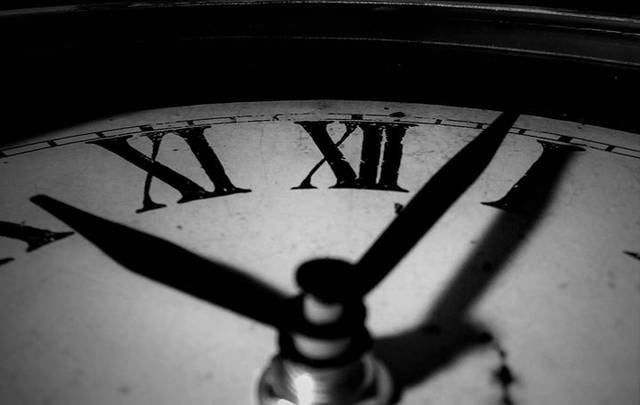
Museum, Room escape games, Art gallery
Address: 310 E Main St, 22902-5234 Charlottesville
Albemarle County Courthouse Historic District
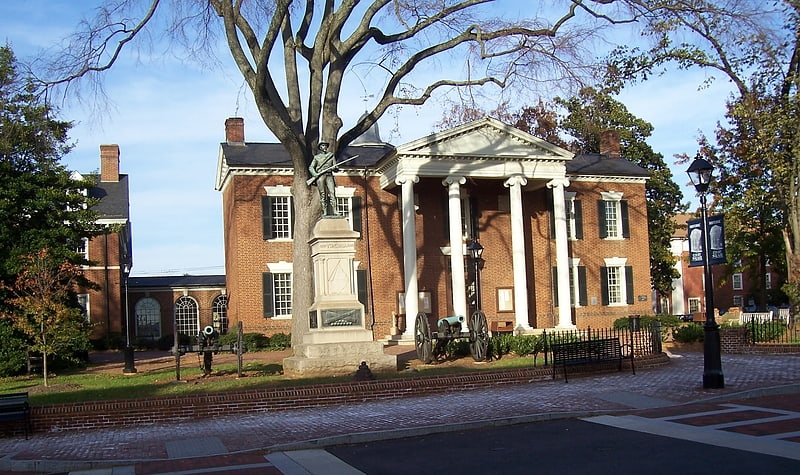
Albemarle County Courthouse Historic District is a historic courthouse and national historic district located at Charlottesville, Virginia. The district encompasses 22 contributing buildings and 1 contributing object centered on Court Square. The original section of the courthouse was built in 1803 in the Federal style and is now the north wing. The courthouse is a two-story, five-bay, "T" shaped brick building with a Greek Revival style portico. Other notable buildings include the Levy Opera House, Number Nothing, Redland Club, and Eagle Tavern.
It was listed on the National Register of Historic Places in 1973. The district was incorporated into the Charlottesville and Albemarle County Courthouse Historic District in 1982.[23]
Address: 410 East High Street, Charlottesville
The Garage
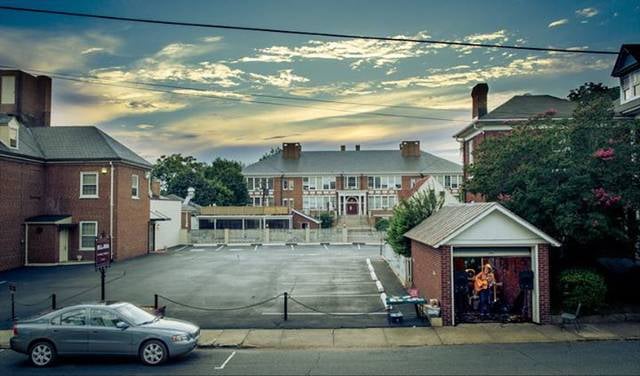
Concerts and shows, Theater
Address: 100 W. Jefferson St, Charlottesville
Albert and Shirley Small Special Collections Library
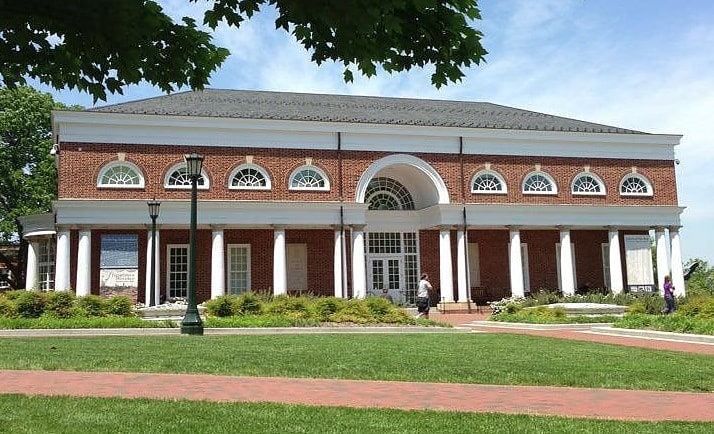
Library in Albemarle County, Virginia. The Albert and Shirley Small Special Collections Library at the University of Virginia is a research library that specializes in American history and literature, history of Virginia and the southeastern United States, the history of the University of Virginia, Thomas Jefferson, and the history and arts of the book. The library is named after Albert and Shirley Small, who donated substantially to the construction of the library's current building. Albert Small, an alumnus of the University of Virginia, also donated his large personal collection of "autograph documents and rare, early printings of the Declaration of Independence." This collection includes a rare printing of the Dunlap broadside of the Declaration of Independence. Joining the library's existing Dunlap in the Tracy W. McGregor Collection of American History, Small's copy made U.Va. the only American institution with two examples of this, the earliest printing of the nation's founding document. It also includes the only letter written on July 4, 1776, by a signer of the Declaration, Caesar Rodney. The Albert H. Small Declaration of Independence Collection boasts an interactive digital display which allows visitors to view the historical documents electronically, providing access to children and an opportunity for visitors to manipulate the electronic copies without risk of damage to the original work.
Though the collections cover a range of fields, the library is best known for the Tracy W. McGregor Library of American History, the Clifton Waller Barrett Library of American Literature, the William Faulkner collections, Jorge Luis Borges Collections, the Sadleir-Black Collection of Gothic Fiction, extensive book, manuscript, and photography holdings in Virginia history, and original documents of the works, life, and legacy of Thomas Jefferson. Additional strengths include historical papers of James Madison, Dolly Madison and James Monroe, typography and other book arts, trade catalogues, slave narratives, equestrianism and other forms of traditional sports, documents, correspondence and oral records of the Southern Civil Rights Movement, political and public affairs papers of major Virginia political figures, and one of the world's largest collections of miniature books.[24]
Address: University of Virginia, 22903 Charlottesville
George Rogers Clark Monument
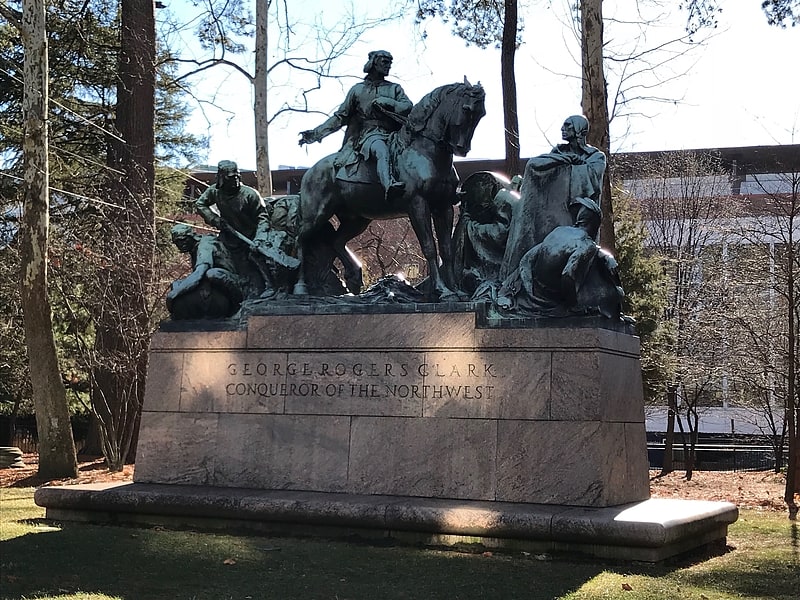
Sculpture by Robert Ingersoll Aitken. The George Rogers Clark Monument was a historic monument consisting of multiple figures that was formerly located in Monument Square at Charlottesville, Virginia. Erected in November 1921, the monument consisted of seven figures, by the sculptor Robert Ingersoll Aitken, presented on the same pedestal. It was the last in a sequence of four works commissioned from members of the National Sculpture Society by philanthropist Paul Goodloe McIntire during the years 1919 to 1924. The sculpture was added to the National Register of Historic Places in 1997.
The monument measured approximately 24 feet in height, 20 feet in length, and 8 feet in width. It included a tall bronze figure of George Rogers Clark mounted on a stallion in the center. The pedestal bore the inscription: "GEORGE ROGERS CLARK/ CONQUEROR OF THE NORTHWEST".
The monument was removed by the University of Virginia on July 11, 2021. No immediate plan for what would be done with it was announced, although the university said it would consult with its students and members of the Native American community of Charlottesville when deciding what to do with it.[25]
Woolen Mills Chapel

Chapel in Charlottesville, Virginia. Woolen Mills Chapel is a historic chapel located at 1819 E. Market Street in Charlottesville, Virginia. The Late Victorian building was constructed in 1887.
It was listed on the National Register of Historic Places in 1982, and included in the Woolen Mills Village Historic District in 2010.[26]
Address: 1819 E Market St, 22902 Charlottesville
Carter–Gilmer House

Carter–Gilmer House is a historic home located at Charlottesville, Virginia. It was built about 1820, and is a three-story, three bay, Federal style brick townhouse dwelling. The house has been divided into apartments.
It was listed on the National Register of Historic Places in 1982.[27]
Address: 800 East Jefferson Street, Charlottesville
Kluge-Ruhe Aboriginal Art Collection

Museum in Albemarle County, Virginia. The Kluge-Ruhe Aboriginal Art Collection of the University of Virginia houses one of the finest Indigenous Australian art collections in the world, rivaling many of the collections held in Australia. It is the only museum outside Australia dedicated solely to Indigenous Australian art. The museum houses many important breakthrough paintings of the Papunya Tula movement and Arnhem Land artists. The collection comprises more than 2000 objects in a variety of media, including bark and acrylic paintings, sculpture, photography, prints and artifacts. The director of the Kluge-Ruhe Aboriginal Art Collection is anthropologist Margo Smith AM.
The museum is located at Pantops Farm, a university-owned property once owned by Thomas Jefferson in the Pantops neighborhood of Charlottesville, Virginia.[28]
Address: 400 Worrell Dr, Charlottesville
Clark Hall
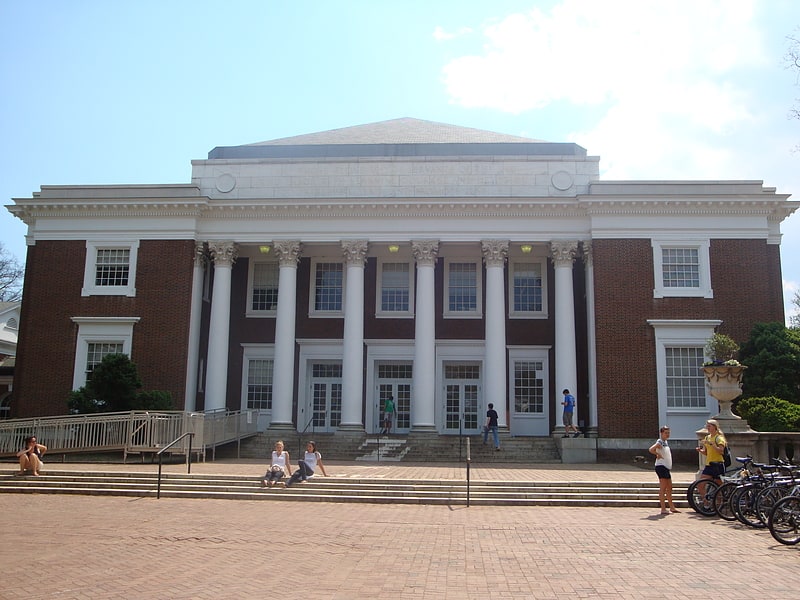
Clark Hall is a building on the campus of the University of Virginia in Charlottesville, Virginia. It was completed in 1932 to hold the university's School of Law. Its two-story, sky-lit, mural-decorated Memorial Library room "is one of the Commonwealth's most significant 20th-century architectural interiors". The building was listed on the National Register of Historic Places on September 5, 2008.
It is the 10th property listed as a featured property of the week in a program of the National Park Service that began in July, 2008. Today the building houses the University's Department of Environmental Sciences and the Charles L. Brown Science and Engineering Library.[29]
The Glass Palette ~ Interactive Glass Art Studio
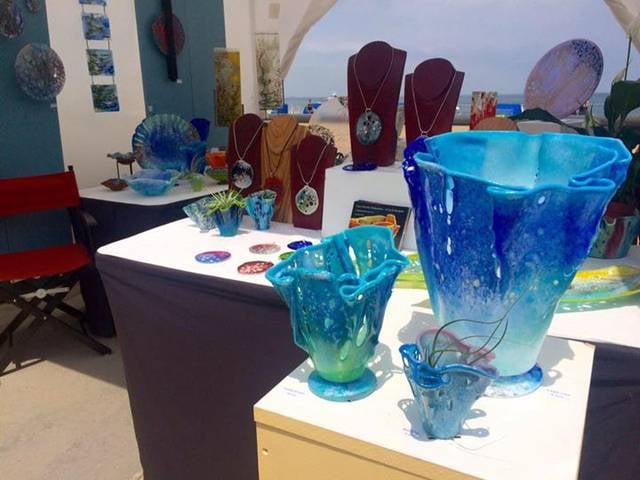
Museum, Historical place
Address: 1304 E Market St, 22902-5468 Charlottesville
Mount Zion Baptist Church
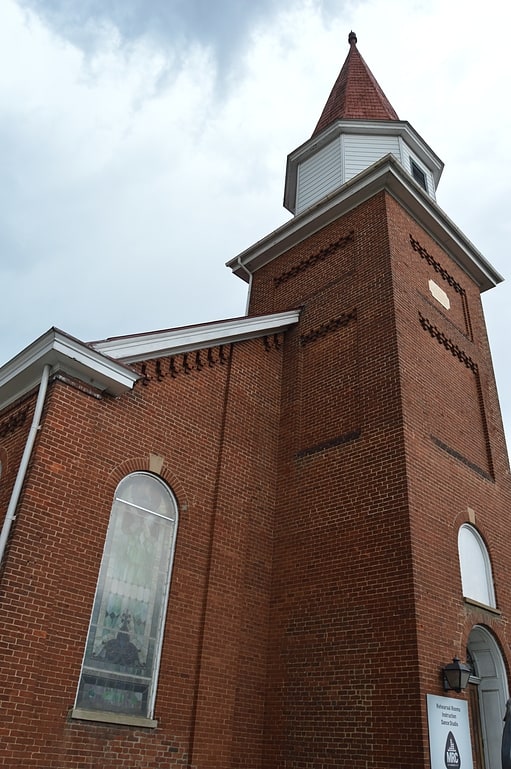
Church. Mount Zion is a historic Baptist church located at Charlottesville, Virginia. Although the current Mount Zion Baptist Church has only been in existence since 1884, the roots of the church are much deeper. The church began with a petition in 1864 to separate from the segregated white Baptist church, and the congregation was officially organized in 1867. Initially taking residence in the house of Samuel White, the congregation soon grew too large for the house, and in 1875 built a wooden church in the lot next door. In 1884, they finished the current, brick church that still stands today. The church was designed by George Wallace Spooner, who also helped rebuild the Rotunda at the University of Virginia.
Rich in cultural history, the Mount Zion Baptist Church has seen more than just prayer. A social and political hub for African-Americans, it has seen the turbulent times of Jim Crow, the Civil Rights Movement, and Urban Renewal. The congregation is still in place today, and the church remains a pillar of strength and pride in the black community.
In 1966 the Minister of the Mount Zion Baptist Church was J.B. Hamilton and the Clerk was Mrs. Ethel P. Nicholas.
It was listed on the National Register of Historic Places in 1992.[30]
The Bridge Progressive Arts Initiative
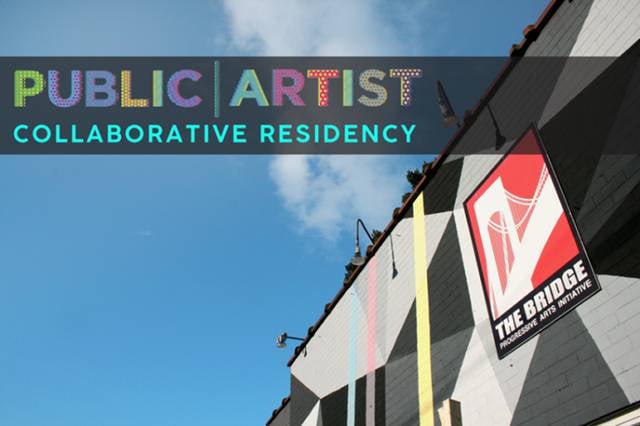
Museum
Address: 209 Monticello Rd, Charlottesville
Clifton

Clifton is a historic home located near Shadwell, Albemarle County, Virginia. It was built about 1800, and is a large, rambling two-story, five bay, wood frame dwelling. The house has later 19th- and 20th-century Colonial Revival-style additions and alterations. The front facade features a double level porch, added about 1930, and the interior has Federal details. Also on the property are the contributing brick office; the ruins of an early 19th-century spring house; the shaft of a 19th-century stone-lined ice house; an early 20th-century chicken coop and an altered 1920s brick garage.
Clifton was built by Congressman and Virginia Governor Thomas Mann Randolph, Jr. (1768–1828), who was married to Martha Jefferson, the daughter of President Thomas Jefferson. It was part of the never-to-be port of North Milton, a sister port to the now extinct village of Milton directly across the Rivanna River. With his partners, Randolph planned North Milton to support commercial and agricultural development, situated along the Milton Canal of the Rivanna River. The Clifton house first began as a warehouse and Randolph had a separate office building, which is still on the Clifton grounds. The house was expanded later and during the 19th century it had a one-story veranda, which has been replaced by the portico. Situated on 100 acres, it has operated as an inn since 1983. It was added to the National Register of Historic Places in 1989.[31]
Address: 1296 Clifton Inn Dr, Charlottesville